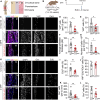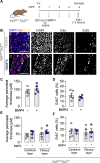YAP regulates transcriptional programs for layer-specific periosteal expansion during fracture repair
- PMID: 40768586
- PMCID: PMC12327455
- DOI: 10.1126/sciadv.adw0126
YAP regulates transcriptional programs for layer-specific periosteal expansion during fracture repair
Abstract
Bone fracture repair initiates by periosteal expansion. The periosteum is a bilayered tissue composed of inner cambium and outer fibrous layers. Typically quiescent, periosteal progenitor cells proliferate upon fracture; however, the underlying transcriptional mechanisms remain unclear. Here, we show that deletion of the transcriptional regulators, yes-associated protein (YAP) and transcriptional coactivator with PDZ binding motif (TAZ), from Osterix-expressing cells, which reside in the cambium, impairs periosteal expansion. YAP activation increases chromatin accessibility, preferentially at TEA domain transcription factor (TEAD) binding sites, and regulates both cell-intrinsic and cell-extrinsic cellular functions. We identify bone morphogenetic protein 4 (Bmp4) as a YAP-TEAD target gene expressed in the cambium. In YAP/TAZ knockout mice, BMP4 delivery increased periosteal expansion through matrix accumulation and fibrous layer cell proliferation. Conversely, in wild-type mice, BMP4 delivery increased osteogenic activity and angiogenesis. Together, these data identify YAP-mediated transcriptional programs that promote layer-specific periosteal expansion.
Figures









Update of
-
YAP regulates periosteal expansion in fracture repair.bioRxiv [Preprint]. 2024 Dec 23:2024.12.23.630086. doi: 10.1101/2024.12.23.630086. bioRxiv. 2024. Update in: Sci Adv. 2025 Aug 8;11(32):eadw0126. doi: 10.1126/sciadv.adw0126. PMID: 39764016 Free PMC article. Updated. Preprint.
References
-
- Duhamel du Monceau H. L., Stack T. IV, Observations and experiments with madder-root, which has the faculty of tinging the bones of living animals of a red colour, by M. Du Hamel du Monceau, F.R.S. & c. communicated in a letter to Sir Hans Sloane, Bart. Pr. R.S. Translated from the French by T.S. M.D.F.R.S. Phil. Trans. R. Soc. 41, 390–406 (1740).
-
- Utvag S. E., Grundnes O., Reikeraos O., Effects of periosteal stripping on healing of segmental fractures in rats. J. Orthop. Trauma 10, 279–284 (1996). - PubMed
-
- Nakashima K., Zhou X., Kunkel G., Zhang Z., Deng J. M., Behringer R. R., de Crombrugghe B., The novel zinc finger-containing transcription factor osterix is required for osteoblast differentiation and bone formation. Cell 108, 17–29 (2002). - PubMed
-
- Kaback L. A., Soung D. Y., Naik A., Smith N., Schwarz E. M., O'Keefe R. J., Drissi H., Osterix/Sp7 regulates mesenchymal stem cell mediated endochondral ossification. J. Cell. Physiol. 214, 173–182 (2008). - PubMed
-
- Hixon K. R., McKenzie J. A., Sykes D. A. W., Yoneda S., Hensley A., Buettmann E. G., Zheng H., Skouteris D., McAlinden A., Miller A. N., Silva M. J., Ablation of proliferating osteoblast lineage cells after fracture leads to atrophic nonunion in a mouse model. J. Bone Miner. Res. 36, 2243–2257 (2021). - PMC - PubMed
MeSH terms
Substances
Grants and funding
LinkOut - more resources
Full Text Sources

